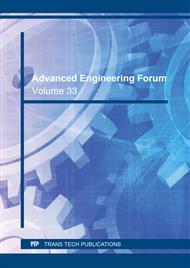[1]
T.S. LE, C.K. Huynh, Human-crowd density estimation based on gabor filter and cell division, Int. Conf. Adv. Comput. Applicat. (2015) 157- 161.
Google Scholar
[2]
S. Srivastava, K.K Ng, E.J. Delp, Crowd flow estimation using multiple visual features for scenes with changing crowd densities, 8th IEEE Int. Conf. Adv. Video and Signal-Based Surveillance, (2011) 60- 65.
DOI: 10.1109/avss.2011.6027295
Google Scholar
[3]
Y. Yuan, C. Qiu, W. Xi, J. Zhao, Crowd density estimation using wireless sensor networks, presented at the 7th Int. Conf. Mobile Ad-hoc and sensor network, (2011) 139-145.
DOI: 10.1109/msn.2011.31
Google Scholar
[4]
S. Depatla, A. Muralidharan, Y. Mostofi, Occupancy estimation using only wifi power measurements, IEEE J. Select area in Commun., Vol. 33, No. 7, (2015) 1381-1393.
DOI: 10.1109/jsac.2015.2430272
Google Scholar
[5]
M. Handte, E.M. Munoz, S. Izquierdo "Crowd density estimation for public transport vehicles, EDBT/ICDT 2014 Joint Conf, (2014) 315-322.
Google Scholar
[6]
C. Huang, C. Chan, ZigBee-based indoor location system by k-nearest neighbor algorithm with weighted RSSI, 2nd IntsConf on Ambient System Networks and Technologies, (2011) 58-65.
DOI: 10.1016/j.procs.2011.07.010
Google Scholar
[7]
S. Fadhlullah, W. Ismail, A Statistical Approach in Designing an RF-Based Human Crowd Density Estimation System, International Journal of Distributed Sensor Networks (2016).
DOI: 10.1155/2016/8351017
Google Scholar
[8]
H. Wang, W. Wang, H. Zhang, Human Body Detection of Wireless Sensor Network Based on RSSI, 26th Chinese Control and Decision Conference (2014) 4879-4884.
DOI: 10.1109/ccdc.2014.6853047
Google Scholar
[9]
K. Yabata, Y. Matsuda, K. Shin, M. Nishi, Proposal of housing-site human detection system in 920 MHz band, IEEE 6th Global Conference on Consumer Electronics (2017).
DOI: 10.1109/gcce.2017.8229476
Google Scholar
[10]
H. Zhu, F. Xiao, L. Sun, X. Xie, R. Wang, Robust Passive Static Human Detection with Commodity WiFi Devices, IEEE 36th International Performance Computing and Communications Conference (2017).
DOI: 10.1109/pccc.2017.8280447
Google Scholar
[11]
C. Wu, Z. Yang, Z. Zhou, X. Liu, Y. Lui, J. Cao, Non-Invasive Detection of Moving and Stationary Human With WiFi, IEEE Journal on Selected Areas in Communications (2015) 2329-2342.
DOI: 10.1109/jsac.2015.2430294
Google Scholar
[12]
D. Wu, D. Zhang, C. Xu, H. Wang, X. Li, Device-Free WiFi Human Sensing: From Pattern-Based to Model-Based Approaches, IEEE Communications Magazine (2017) 91-97.
DOI: 10.1109/mcom.2017.1700143
Google Scholar
[13]
K. Ohno, D. Echizenya, T. Shigenobu, IEEE 17th International Conference on Ubiquitous Wireless Broadband (2017).
DOI: 10.1109/icuwb.2017.8250978
Google Scholar
[14]
S. Hosseinzadeh . 3D Ray Tracing For Indoor Radio Propagation [Online]. Available: https:// www.mathworks.com/ matlabcentral/ fileexchange/ 64695-3d -ray- tracing- for-indoor- radio-propagation), MATLAB Central File Exchange. Accessed on: December 2, (2018).
DOI: 10.1109/pimrc.2007.4394431
Google Scholar
[15]
BTS Trains System. (n.d.). [Online]. Available: http://203.146.21.155/corporate/en/ 02_system_mk1.aspx. Accessed on April 02, (2018).
Google Scholar
[16]
C.Gabriel, Compilation of the dielectric properties of body tissues at RF and microwave frequency, Occupational and Environmental health Directorate, (1996).
Google Scholar
[17]
D.Fofanov, S.Riedner, Magnetic properties of stainless steels: applications, opportunities and new developments.
Google Scholar
[18]
XBee®/XBee-PRO® RF Modules Product Manual v1.xEx - 802.15.4 Protocol (2009) [Online]. Available: https://www.sparkfun.com/datasheets/Wireless/Zigbee/XBee-Datasheet.pdf, Accessed on: August. 5, (2017).
DOI: 10.1016/b978-0-12-391404-0.00032-6
Google Scholar
[19]
D. D. Coleman, D. A. Westcott, Radio Frequency (RF) Fundamentals, in CWNA: Certified Wireless Network Administrator Official Study Guide, Wiley, (2002) 26-27.
DOI: 10.1002/9781119549406.ch3
Google Scholar
[20]
D. Adler Basic design Data, in Metric Handbook Planning and Design data, Arch. Press, (1970) 22-24.
Google Scholar
[21]
I. Dove, Analysis of radio propagation inside the human body for inbody localization purposes, M.S. thesis, Faculty Elect. Eng. Math. Comput. Sci., Univ, (2014).
Google Scholar
[22]
M. Arai, H. Kawamura, K. Suzuki Estimation of Zigbee's RSSI fluctuated by crowd behavior in indoor space, presented at SICE Ann. Conf., (2010).
Google Scholar


